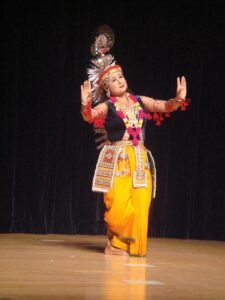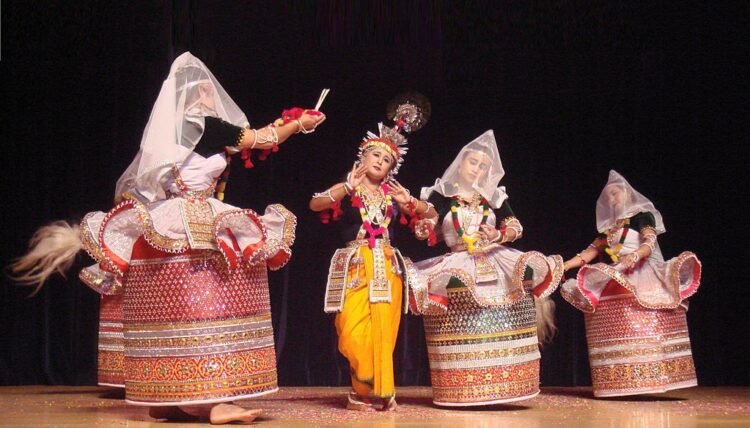No products in the cart.
Manipur – A Gem of a Land
Manipur
Manipur may be tiny, but it’s big on beauty and culture, history and heritage
Cocooned between Nagaland on the north, Mizoram on the southwest, Myanmar on the east, and Assam on the west, Manipur is a languid setting of low hills and lush plains which are home to the Meitei who dominate the populace, which is a mix of Naga and Kuki-Chin Mizo groups amongst other ethnic communities. The Barak River originates in the Manipur Hills, while Loktak Lake in the central plain is the birthplace of the Manipur River.

Almost 70 percent of the land is under forest cover which also features expensive timbers like teak. Bamboo is a mainstay for many uses, while the state’s floral wealth includes rhododendrons, magnolia, blue poppies, primroses, and the rare Shirui Lily. Manipur has at least 500 different varieties of orchids. Its ancient forests are home to the Asiatic elephant, tigers, leopards, and wild buffalo. At the Keibul Lamjao National Park, the world’s only floating national park, you will also get to see the sangai, the brow-antlered deer, which is facing extinction. The Mithun, found aplenty across Manipur, is a domesticated version of the bison. Manipur’s avifaunal wealth includes the Burmese peafowl, Blythe’s Tragopan, Mrs Hume’s bar-backed pheasant, and four varieties of hornbills.
 Much of Manipur’s ancient history is shrouded in the mists of myth and oral narratives. However, with the passing of time, it remained an internally self-governing princely state during the period of British rule in India. Kangla Royal Palace was the historic seat of administration to Manipur’s Meitei rulers of the Ningthouja dynasty (33 CE to 1891) since Nongda Lairen Pakhangba (33 CE), the mythical ‘God-King’ ascended the throne. The power of the dynasty ended with Maharaj Kulachandra, in 1891 CE, after the British defeated the Manipur Kingdom in the Anglo-Manipur War of 1891. From 1926 until 4 January 1947, Manipur was one of the Pakokku Hill Tracts Districts of British Burma. During World War II it witnessed intense conflicts between Japanese invaders and British Indian forces. In October 1949 Manipur became part of India and went on to become a Union Territory in 1956; in 1972 it was made a fully-fledged state.
Much of Manipur’s ancient history is shrouded in the mists of myth and oral narratives. However, with the passing of time, it remained an internally self-governing princely state during the period of British rule in India. Kangla Royal Palace was the historic seat of administration to Manipur’s Meitei rulers of the Ningthouja dynasty (33 CE to 1891) since Nongda Lairen Pakhangba (33 CE), the mythical ‘God-King’ ascended the throne. The power of the dynasty ended with Maharaj Kulachandra, in 1891 CE, after the British defeated the Manipur Kingdom in the Anglo-Manipur War of 1891. From 1926 until 4 January 1947, Manipur was one of the Pakokku Hill Tracts Districts of British Burma. During World War II it witnessed intense conflicts between Japanese invaders and British Indian forces. In October 1949 Manipur became part of India and went on to become a Union Territory in 1956; in 1972 it was made a fully-fledged state.
From its lavish jaw-dropping natural beauty to the unique aspects of its cultural diversions, Manipur is a treasure trove of exciting possibilities for intrepid travellers.
With the state capital Imphal as the gateway to its touristy hot spots, Manipur’s rich traditions, ethnicity, and natural wonders underpin the tourist experience in the most expressive ways. Unmissable places to enjoy this diversity are Loktak Lake, the Dzukou Valley, Keibul Lamjao National Park, the unique Ema Keithel Market, Shri Govindjee Temple, Kangla Fort and many other historical places.
One of the oldest states in the region Manipur’s royal pursuits from the past are reflected in the graceful Manipuri dance, also referred to as the Manipuri Raas Leela, or the indigenous version of polo, known as Sagol Kangjei.

Also known as the land of Radha and Krishna, Manipur showcases wonderful renditions of the Ras Leela at the annual Lai Haraoba (Spring Festival) celebrated by the Meitei community. Visitors also get ample opportunities to witness some of the expressive tribal folk dances and indigenous sports such as Mukna an indigenous form of wrestling, lamjel (flat race), Thouri Chingbi (tug of war), Khong Kangjei (hockey), Yubi Lakpi (rugby with a coconut).
Treading cautiously into India’s tourism arena Manipur has opened up a whole new world for travellers to experience its distinctive charms in the region. Driven by the abiding mantra of ‘Go Green” it has chosen to move forward with sustainable practices which will ensure the preservation of its natural and cultural heritage.
Air connectivity to Delhi, Mumbai, Kolkata, Guwahati, and major cities of the Northeast is available through Imphal’s Tulihal Airport. Dimapur (216 km) in Nagaland is the closest railhead. Imphal is connected by road with Kohima, Guwahati, Silchar, and Shillong. All domestic tourists visiting Manipur by road via Dimapur-Kohima require an Inner Line Permit to pass through Nagaland. These can be obtained from the Liaison Officers of the Government of Nagaland at New Delhi, Kolkata, Shillong and the Sub-Divisional Officer (Civil), Dimapur and the Deputy Commissioner, Imphal can also issue permits to tourists travelling from Imphal to Kohima and Dimapur in Nagaland. Visitors are also required to obtain an Inner Line Permit (IPL) to travel in a protected/ registered area in Manipur for a limited period.
















